One of the most common emails I get from students is how to prepare for a hard exam, that’s coming soon, that they haven’t prepared for.
Cramming is the act of studying non-stop right before an exam. It usually, although not always, involves review notes rather than doing practice or recall. (A bad idea). It often involves cutting sleep to squeeze more hours in. (Even worse.)
What’s more, cramming is usually the end-phase of a much longer, lousy studying strategy. The early phase involves avoiding studying as much as possible. Only when the looming threat of failure becomes painful enough does studying actually begin. Except, then it’s often too late.
In this article I’d like to first articulate why cramming is a terrible strategy for both learning and memory, why students nonetheless use it, and how you can overcome your own bad habits that lean towards cramming.
Why Cramming Sucks
Cramming is bad for two reasons.
Reason #1: Spacing
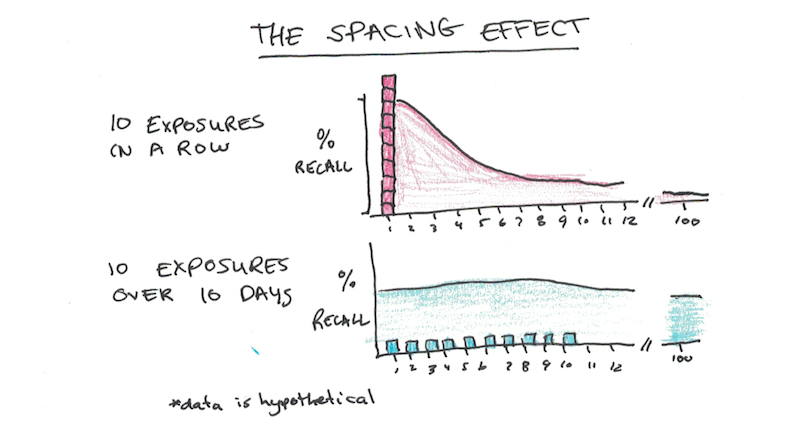
The first has to do with a well-known experimental observation in psychology known as the spacing effect.
The spacing effect says that given the same amount of time studied, or the same number of exposures to material, those spread out in time will be remembered better, at longer intervals, than if those same exposures are crammed together.
In other words, if you have ten hours to study, you’ll retain more if they are spread one hour per day over ten days, than if you study ten hours straight.
Reason #2: Review
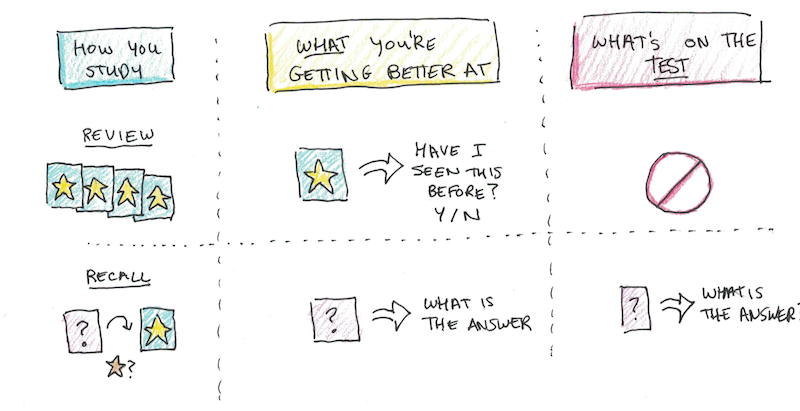
The second reason cramming is bad is that it tends towards less effective learning strategies.
When you’re studying almost non-stop for a few days, you’re going to get tired. As a result, you’re going to start picking studying activities that are less effortful, even if they aren’t as helpful for your actual learning goals.
?One of those strategies is reviewing notes. This means you pick up a textbook or classroom notes and simply read it, over and over again, until you feel like you’ve memorized it.
The problem is that this strategy doesn’t work very well. When you actually get tested on the information, you’re going to need to retrieve the information from your brain. But this isn’t what you’re practicing when you review—instead you’re only practicing the ability to recognize the information. As a result, when the test comes, you haven’t actually cultivated the skill you need to perform well on the test.
It’s actually worse than this though. Due to a cognitive quirk, you often feel like you know the material, because you’re able to recognize it better and better each time you review. The problem is that you can’t actually use it very easily on the exam.
This leads to the common lament of students that they knew all the information, but that the test was unfair or that they just froze on the test. The test was fair and you didn’t freeze. You just didn’t study properly.
Why You Cram (Even Though Cramming Sucks)
Despite these problems, most students do some kind of cramming, to varying degrees. If cramming is so lousy, though, why do students do it?
Cramming May Have Some Short-Term Benefits
Remember when I said that the spacing effect shows that spread out studying improves retention long-term. That’s true.
But crammed studying may have slightly better performance on extremely short time scales. In other words, if you cram a bunch of stuff right before the test, you may be able to remember it for a day or two.
As a result, cramming can allow you to occasionally squeeze through classes you’d normally fail. The problem is that the knowledge is rapidly forgotten, so by the next class you take, it’s mostly forgotten and you’re even further behind than before.
That said, don’t take this as a secret hint to cram more right before the test. Due to inefficient studying strategies (and possibly losing sleep) this benefit may actually evaporate. Still, it offers a short-term promise to students in an impending crisis.
The Deeper Reason Why You Cram
The deeper reason students cram has a lot more to do with the emotions they attach to studying than it does to any perceived cognitive benefit.
You cram because you don’t enjoy studying very much. In the beginning, it’s easy to procrastinate or avoid studying, because the threat of failure is distant. Later, it gets harder and harder to ignore, so that the short-term pain of failure overwhelms your short-term dislike of studying.
Here’s a simple model you can use to understand why cramming is a default behavior for so many students.
Why Your Brain Chooses to Cram
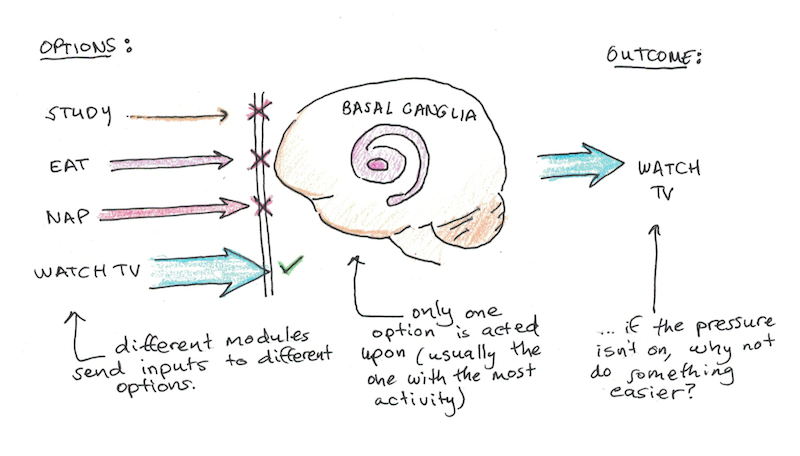
Your choices about what to do next are mediated by an internal structure known as the basal ganglia. One function of this structure is to take “votes” from other regions of the brain about what to do. Perhaps one part of your brain wants to study, another wants to slack off, another wants to have a sandwich, another wants to sleep, etc.
In the end, the basal ganglia only lets one of these options through, based on how strongly that option has been activated. Your environmental cues along with innate and reinforced preferences select the “best” option, and that ends up being your choice.
To simplify this, imagine that you have some amount of motivation to study. This can be driven by the need to achieve, fear of failure, intrinsic interest in the subject or any other factor.
Imagine you also have some aversion to studying. This can be driven by wanting to avoid mental effort, fear that you’ll get questions wrong or simply wanting to avoid boredom.
Studying will only take place when motivation > aversion. If aversion > motivation, you’ll do something else to procrastinate instead.
In the beginning of a semester, your desire to study is lower. The exam is off in the distance, so you’re not as afraid of failure or as motivated to succeed. The aversion, however, is mostly constant (perhaps even a little higher if the subject is new), so aversion wins out.
As time progresses, fear of failure increases until motivation is finally higher than aversion. You start studying. Except now it’s too late. Thinking you might fail, you study more and more, even as your methods become less and less effective.
How to Stop Cramming and Adopt Better Studying Habits
Once you understand the deeper reasoning behind why you study, this also suggests that any solution you adopt must take one of two forms:
- Either you need to make studying more pleasant (reduce aversion)
- Or, you need to make your desire to study higher (more motivation)
Option One: Making Studying Less Aversive
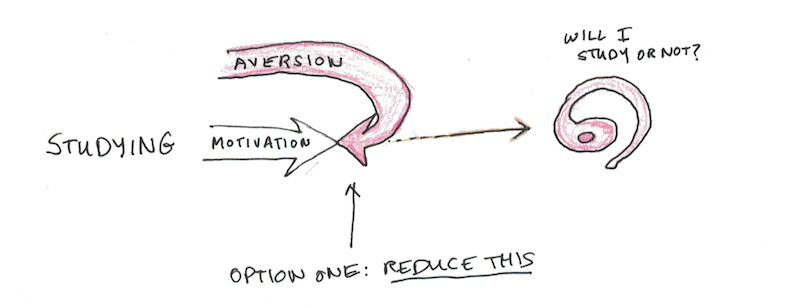
The first strategy is to focus on making the studying itself less aversive. The easiest way you can do that, in my opinion, is to set small habits which make the act of studying less painful.
If you often wait right until the end of the semester to start studying, a good start might be to set a habit to do just a little bit every single day. This may not completely overcome your cramming, but it can offset it.
If you already do some studying in the semester, and you simply panic right near the exam, you may want to focus on redesigning your studying habits so that you can make them more effective and consistent from the beginning. This is a big topic, which I discuss in my course, Rapid Learner.
A big part of what makes studying aversive is frustration and negative feedback. These too, are dials you can tweak to adjust your desire to study. If something is too frustrating, you may want to deliberately go through your studying material super slowly. This can help you feel like you “get it” before being pushed to move on.
I would have a little rule when doing flashcards which also helped avoid the sting of negative feedback: I had to keep going until I got one right. Since failed flashcards will get repeated, this always happens sooner or later. But it prevented me from quitting out of frustration and building up a negative feeling about doing the flashcards.
Option Two: Increase Your Motivation to Learn
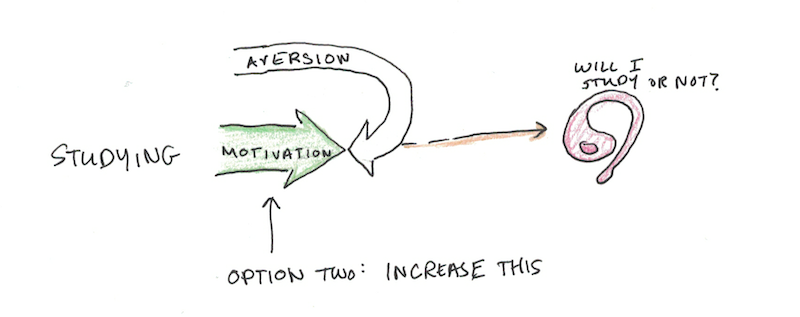
The second strategy is to increase your motivation to study. There’s a few ways you can do this.
The first is setting clear goals and making a concrete plan. This can often motivate you by focusing your mind on the thing you desire (in the beginning). Later, it can motivate by becoming a commitment you feel pressured to keep for yourself.
Another is to cultivate an intrinsic interest in the subject. If you can dig deep enough to see why the thing you’re studying is fascinating, then you’ll be less reluctant to pick up a book and read about it.
Finally, you can use commitment tools. Try a daily calendar where you put an X on each day when you complete your minimum daily studying goal. Looking at the calendar every day can take some of the motivation you feel before exams and bring it into the present. Or you might try accountability partners, or apps which force you to pay up if you don’t meet your habits.
What Should You Do Instead of Cramming?
Cramming doesn’t work. But it’s often hard to break this bad habit, because the motivation-aversion balance doesn’t tip in favor of action until it’s already too late.
Take some time to think about what it is that you find unpleasant about studying. How could you diminish those or make them more palatable? Think about what you could do to ramp up your motivation to study, especially in the earlier parts of the semester when you normally don’t do enough?
Finally, adopt effective learning strategies. Don’t just review—cover up the book and see how much you can recall. Do practice problems. Create explanations for what you learn, rather than just passively absorbing them.
Getting over cramming isn’t easy. But if you make small changes to your habits now, you can avoid the pain, stress and fear of failure that looms during exam time.


 I'm a Wall Street Journal bestselling author, podcast host, computer programmer and an avid reader. Since 2006, I've published weekly essays on this website to help people like you learn and think better. My work has been featured in The New York Times, BBC, TEDx, Pocket, Business Insider and more. I don't promise I have all the answers, just a place to start.
I'm a Wall Street Journal bestselling author, podcast host, computer programmer and an avid reader. Since 2006, I've published weekly essays on this website to help people like you learn and think better. My work has been featured in The New York Times, BBC, TEDx, Pocket, Business Insider and more. I don't promise I have all the answers, just a place to start.